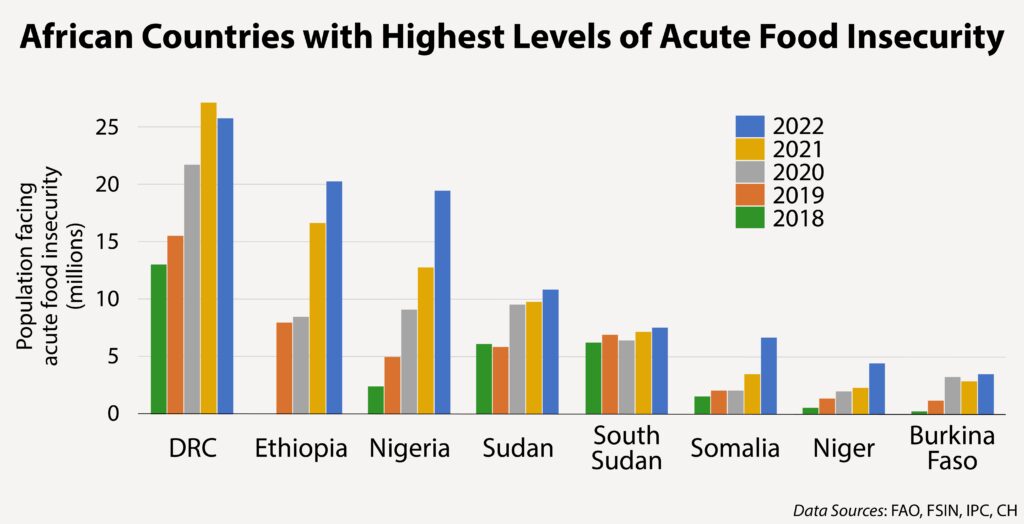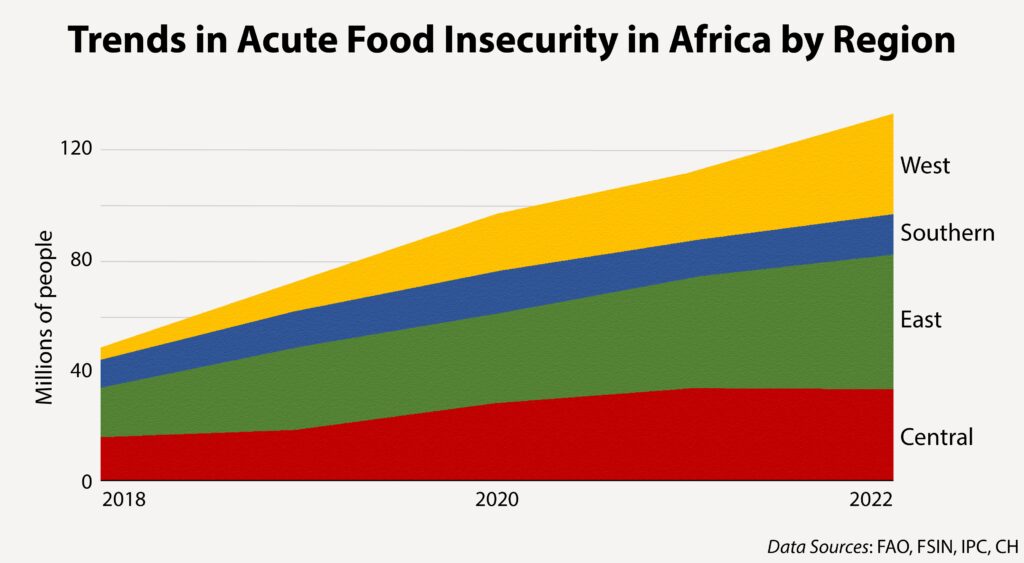
More than 80 percent of the record 137 million Africans facing acute food insecurity are in conflict-affected countries underscoring that conflict continues to be the primary driver of Africa’s food crisis.
Highlights
More than 137 million Africans are facing acute food insecurity—when a person’s inability to consume adequate food puts their lives or livelihoods in immediate danger. This equates to a risk category of 3 or higher (crisis, emergency, and famine) on the Integrated Food Security Phase Classification (IPC) scale of 1 to 5.
This figure represents a 22-percent increase in the number of Africans facing acute food insecurity over the past year—and a near tripling since 2018.
The expansion in numbers of Africans facing acute food insecurity continues an uninterrupted trend over the past decade. In 2013, there were 15.8 million acutely food insecure in the hardest hit countries on the continent.
“Some 111 million of those facing acute food insecurity are in countries experiencing conflict—81 percent of the total.”
Some 111 million of those facing acute food insecurity are in countries experiencing conflict—81 percent of the total. This underscores the massive indirect—and often unrecognized—human costs of Africa’s conflicts.
8 of the top 10 African countries experiencing acute food insecurity are facing conflict.
By compromising household, community, and national resiliency, Africa’s conflicts have compounded the impact of external shocks—pandemic, climate, inflation, and Russia’s war in Ukraine—on the continent’s food security.An estimated 73 percent of acute food insecurity on the continent is concentrated in eight countries: the Democratic Republic of the Congo (DRC), Ethiopia, Nigeria, Sudan, South Sudan, Somalia, Niger, and Burkina Faso.
Acute food insecurity has been growing progressively worse in each of these countries facing ongoing conflict, as shown by the staircase pattern in the annual figures of people who are acutely food insecure.
The DRC continues to have the largest number of highly food insecure people in the world (25.9 million). This food vulnerability is concentrated in the east of the DRC, where an estimated 120 armed groups, some sponsored by neighboring countries, have perpetuated instability for years.
There are an estimated 20 million people in Ethiopia in need of food aid (a 137-percent increase from 2020). This spike in acute food insecurity is largely the result of the civil conflict that began in November 2020 and has engulfed Tigray and other parts of northern Ethiopia.
In Nigeria, 19.5 million people are experiencing acute food insecurity. This is nearly a 10-fold increase from 2018 when there were 2.5 million acutely food insecure in the country. Most of the critically food insecure live in the northeastern region that has been destabilized by Boko Haram and its offshoot, the Islamic State of West Africa. At least 1 million people are estimated to be outside the reach of humanitarian assistance. With militant and organized criminal violence spreading into the north central and northwestern parts of the country, Nigeria saw an increase of 6.5 million people facing acute food insecurity over the past year—a 51-percent spike.
“Acute food insecurity has been growing progressively worse in each of these countries facing ongoing conflict.”
Sudan has experienced years of civil conflict in its Darfur, Blue Nile, and South Kordofan regions—outcomes of the repressive military government that has ruled the country for decades. The number of people facing acute food insecurity shot up in the past year from 6 million to 11.7 million—most of whom are concentrated in the conflict-affected regions. This followed a military coup that derailed the democratic transition and the resumption of conflict and population displacements. The food crisis has been further compounded by economic mismanagement that has led to 400 percent inflation.
Due to a civil war that has dragged on for a decade, South Sudan has had a persistently high number of people experiencing food crisis despite having one of the most fertile and land abundant countries on the continent. The 7 million facing acute food insecurity in South Sudan comprises roughly two-thirds of the entire population—the highest rate of any country in Africa. This includes 90,000 facing famine.
In Somalia, about 6.7 million people are facing acute food insecurity, a near doubling in the past year. This includes at least 300,000 facing famine. The majority of those facing famine are residents and displaced people living in Baidoa and Burhakaba districts, which overlap territory controlled or contested by al Shabaab. A fifth season of poor rainfall is exacerbating the disruptions to food production and transportation caused by the conflict.
“South Sudan has had a persistently high number of people experiencing food crisis despite having one of the most fertile and land-abundant countries on the continent.”
The deteriorating security situation in the western Sahel caused by militant Islamist groups has precipitated a major food crisis. Some 9.7 million people in Mali, Burkina Faso, and Niger are facing acute food insecurity. This represents a 50-percent increase over the past year. In 2018, there were 1.1 million people acutely food insecure in the three countries.
The conflict in the Sahel has displaced nearly 3 million people—farmers, herders, traders among them—and has prevented humanitarian assistance from reaching many of them. With a record 36 million Africans forcibly displaced by conflict and repressive governance across the continent, these populations are particularly vulnerable and at risk of tipping from designations of crisis to catastrophe.
Given the central role of conflict in Africa’s food insecurity crisis, conflict resolution and peacebuilding initiatives are critical elements to reversing the continent’s deteriorating food security trendlines.
